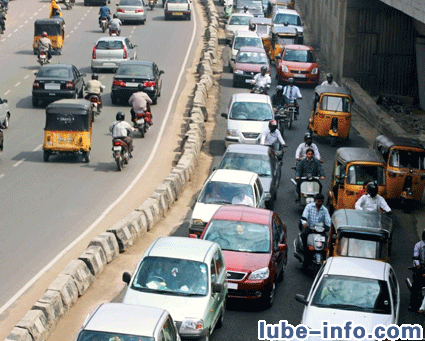HIGH VOLUME LOW QUALITY
2016-06-20 来源:润滑油情报网
Despite recent mixed signals, there is still plenty to get excited about with
However, in spite of the tantalizing scale, qualitative considerations may tone down the appetite that international lubricant companies have for
“First of all it is very price sensitive,” he said in an interview, “and secondly there is the widespread problem of counterfeiting, which has been an issue for international companies.”
In all, “the Indian [lubricant] market is estimated around 2.1 million tons and valued at approximately U.S. $3.8 billion [€3 billion] for 2011,” Satyan Gupta, senior consultant at Kline’s Gurgoan office in
Sixty percent of the passenger car motor oil consumed in
Four-stroke engine oils used in two- and threewheelers mostly meet the requirements of API SG or later specifications, with original equipment manufacturers generally recommending SJ. API defines SG as obsolete, while SJ was introduced for model year 2001 vehicles. The four-stroke market is
Ghosal cautioned that declining vehicle utiliza- tion and lengthening drain intervals will partially offset the growth in engine oil demand resulting from a larger vehicle population. Oil viscometrics are transitioning, he said. Owners of older vehicles commonly use SAE 20W-40 oils, but big OEMs such as Hero Motor and Honda are gradually shifting to SAE 10W-30 in
The low quality of oils in
Stricter regulations have been adopted in 13 Indian cities, with Bharat Stage III taking effect in April 2005 and Bharat Stage IV taking effect five years later. Bharat IV corresponds to Euro 4, which went into effect in the EU in 2005.
Low-emission engine technology and a push for greater fuel efficiency will ultimately require better lubricant technology in
As the market evolves it likely will gravitate towards global standards, requiring Indian OEMs to iron out technical issues when redesigning lubricants. Ghosal identified wear protection, gear pitting and overall fuel economy as the most pressing issues. He said that many OEMs have introduced engine oils tailor-made for them by lube blenders who then sell the product as a co-branded oil in the aftermarket. OEMs receive a royalty on such sales.
Kline’s Satyan Gupta thinks loyalty to OEM specifications is shortlived. He said that many heavy industrial consumers import foreign technology or purchase machinery and obtain the lubricant recom- mended by OEMs during the warranty period. “But most of them switch once the warranty is over,” he said. Gupta also agreed that global specifications by automotive OEMs will impact the market. “Viscosities will move from 20W and 15W grades straight to 5W, bypassing 10W-40 and 10W-30 grades. The HDMO market, however, is expected to continue to stick to the heavier grades.”
Domestic OEMs dominate in the heavy- and medium-duty markets, Ghosal wrote, with Tata and Ashok Leyland supplying 63 percent and 28 percent, respectively. The light-duty category is divided mostly between Tata at 65 percent, Eicher at 9 percent, Swaraj at 6 percent and M&M at 5 percent. Tata recommends an API CF-4 oil corresponding to Bharat I/II and with a recommended drain interval of 18,000 km or a CH-4, Bharat II/III oil rated for a 36,000 km interval. Ashok Leyland recommends oils of similar quality with intervals of 16,000 or 32,000 km. Eicher prescribes intervals of 20,000 and 30,000 km.
In some respects the passenger car market appears to offer better chances for engine oil advancement. Ghosal noted that Maruti Suzuki, a subsidiary of
Another vehicle category that merits attention is the Indian tractor market, which is the second largest in the world. The country has more than 2.1 million tractors, Ghosal said, sowing an area of 185 million hectares, and more than 70 percent of them are manufactured by domestic companies. Annual tractor sales have more than doubled since 2004-05 and are forecast to grow between 12 to 15 percent a year. In 2011-12 nearly 500,000 units were sold. Ghosal contended that the tractor market is in transition – that although it is currently dominated by machines with 31 to 40 horsepower, signs indicate a shift to those with greater than 40 hp and an increase in the number of wet brake models used. The 31 to 40 hp category currently accounts for 49 percent of the country’s tractors.
On the face of it, the Indian lubricants market is growing and could offer enormous potential. Yet, the recent experience of Shell, which withdrew from a joint venture, and Chevron, which pulled out of the market in 2009, suggests a potentially bumpy ride for aspiring companies. Excell Corp.’s Satsangi said that despite the pitfalls the Indian market is still a good bet.
“You have to be in it for the long term, stay put, find a good partner and always remember it is a volume business,” he said. It is a point echoed by Gupta of Kline. “In the medium term there is low potential for new players, but long term there is potential as the lubricants market is expected to enjoy significant organic growth. The best strategy would be to develop some indirect presence through a marketing tie-up.”








 粤公网安备 44010402003386号
粤公网安备 44010402003386号